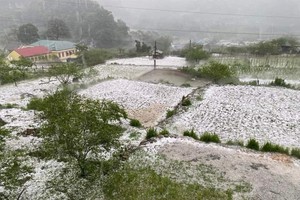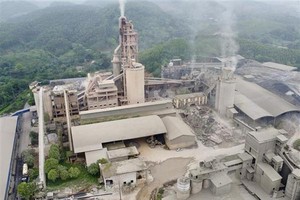The fact that seafood processing factories in Ba Ria - Vung Tau Province discharged untreated wastewater has not only caused massive death of fish cultured at cage fish farms in Tan Hai Commune in Tan Thanh District but also destroyed hundreds of hectares of vegetables and crops here. The situation got worse when wastewater flew into salt evaporation ponds, making the life of salt workers which is already poverty-stricken become more miserable.

Mrs. Nguyen Thi Be Em, a fish farmer in Long Son Commune in Vung Tau City, looked listlessly at empty fish cages on the water surface. Just a few months ago, at around 3-4 p.m, she and her husband were busy with feeding fish and clearing fish cages. Seeing their fish growing day by day made them feel delighted, thinking that they would be able to pay all their debt of more than VND1 billion. However, their 15,000 silver pomfret fish and 3,000 cobia fish which were almost ready for harvest suddenly died all on September 5, 2015. Not only Mrs. Em’s family but also tens of cage fish farming households on Cha Va River in Long Son Commune suffered the same situation. This is not the first time that fish have died massively here. According to Mrs. Em, the situation that fish die massively because of water pollution had occurred several times in three straight years. Fish farmers had sent several reports to local authorities but the problem remained unsolved.
‘It is obvious that seafood processing factories released wastewater and caused water pollution. Even local residents were able to take pictures or film the evidences then why local authorities could not stop their violation but let our fish die over and over instead,’ said Mrs. Em’s husband.
During later days, fish farmers brought dead fish to seafood processing factories and laid them at their front gates then they went to the People’s Committee of Ba Ria – Vung Tau Province to ask for justice. The provincial People’s Committee formed inspection delegations to look into the case. The provincial Bar Association also instructed fish farmers to take legal proceedings against these factories.
It is still unknown how the case will end. However, at the moment, fish farmers in Long Son Commune are facing several difficulties. They do not have money to culture fish again and pay for monthly interest because most fish farmers had to borrow money from banks or even from loan sharks for fish farming. In addition, they cannot afford to hire lawyers and pay legal costs.
According to Mr. Le Xuan Tu, chairman of the People’s Committee of Long Son Commune, some fish farmers have sold or rented their cages out to settle their debts or shifted to other jobs. As for the lawsuit, local authorities are fighting for fish farmers’ interests. In near future, local authorities will propose banks to give financial assistance or preferential financial policies to fish farmers to help them resume production.
Water pollution caused by seafood processing factories also destroyed hundreds hectares of rice and paperbark forest of farmers in Tan Hai Commune in Tan Thanh District. Accordingly, when the 6th sewer where seafood processing factories release their wastewater was closed, wastewater stagnated then flooded surrounding area, affecting nearby rice farmers and salt workers.
Salt evaporation ponds of farmers in Tan Hai Commune have started to form a thin layer of white salt. Surrounding salt evaporation ponds was smelly pink water. Salt workers said that in order to deal with the situation that wastewater flows into salt evaporation ponds, they had to dike and keep watch all day with water pump. Mr. Tran Van Thap, a local salt worker, said that because of saline soil they had to switch to making salt to make ends meet. But now, with wastewater threatening their salt evaporation ponds, they do not know what to count on.
On February 19, the inspection delegation of Tan Thanh District, consisting of the Department of Agriculture and Rural Development, the Department of Natural Resource and Environment, and the People’s Committee of Tan Hai Commune inspected the flooded area. Inspectors said that the flooded area covered around 200 hectares. Up to now, around 30 hectares of rice was dead; 0.7 hectares of rice was completely lost; and more than 200 hectares of crops and vegetables were affected. The soil became salty because the 6 th sewer did not operate appropriately. When flood tide rose, the sewer gate was not closed tightly, allowing sea water to flow into. Meanwhile, when flood tide went down, sea water and wastewater from seafood processing factories were not released. As a result, it caused soil pollution, killed crops and vegetables, and flooded salt evaporation ponds. Currently, 100 hectares of land in this area is at risk of being left fallow.
Figures by the Department of Agriculture and Rural Development of Ba Ria – Vung Tau Province, after four massive deaths of fish, fish farmers on Cha Va River lost more than VND18 billion. they demanded seafood processing factories to compensate VND13.8 billion for the damage. Beside 35 households who suffered losses in the massive death of fish in September 2015, other fish farmers on Cha Va River whose fish were killed in previous years also want to sue seafood processing companies in Tan Hai Commune.
























